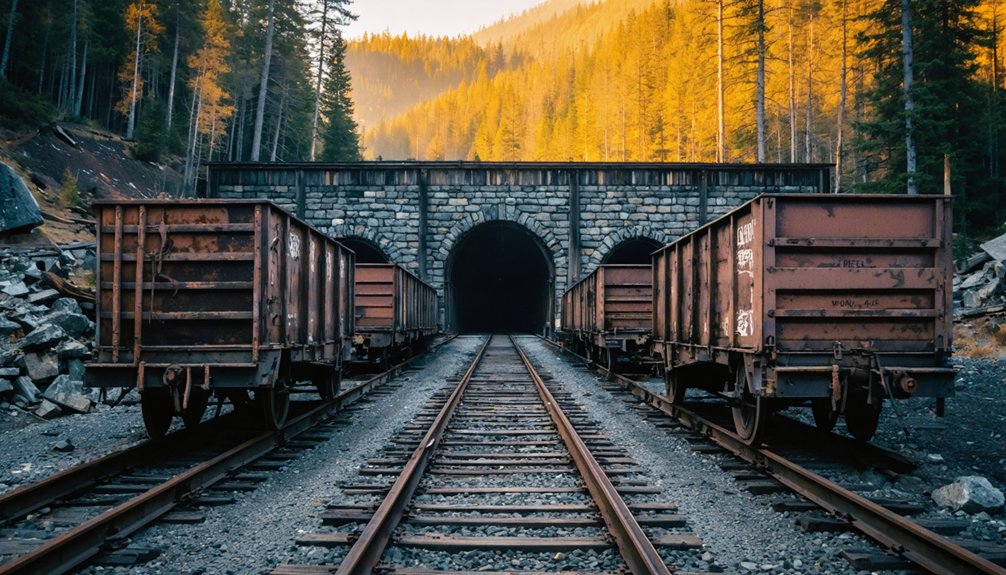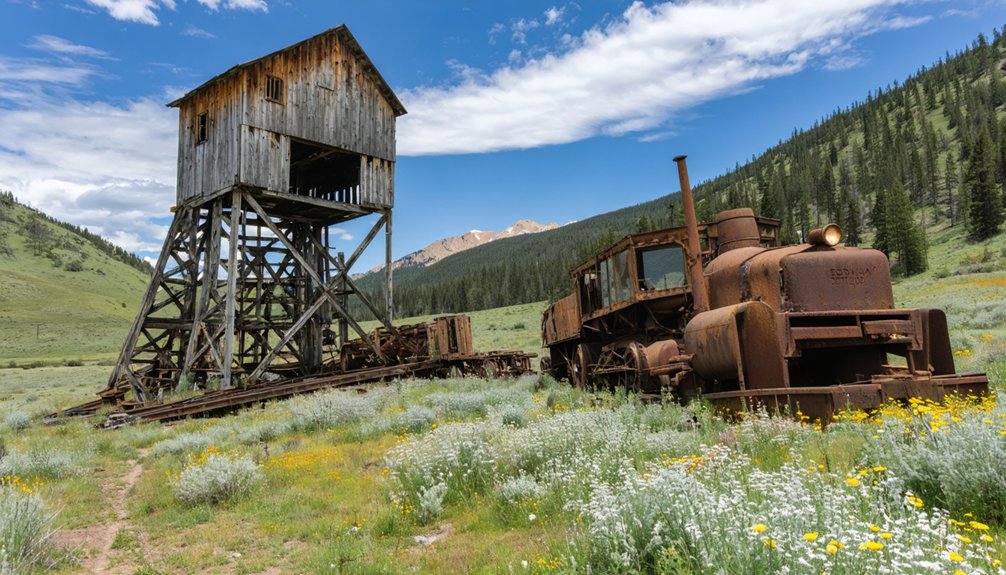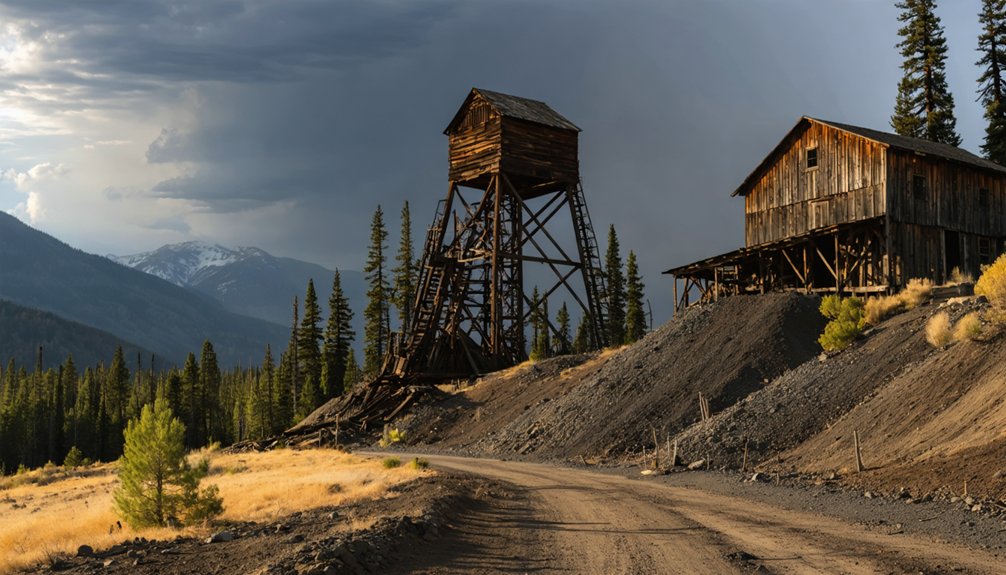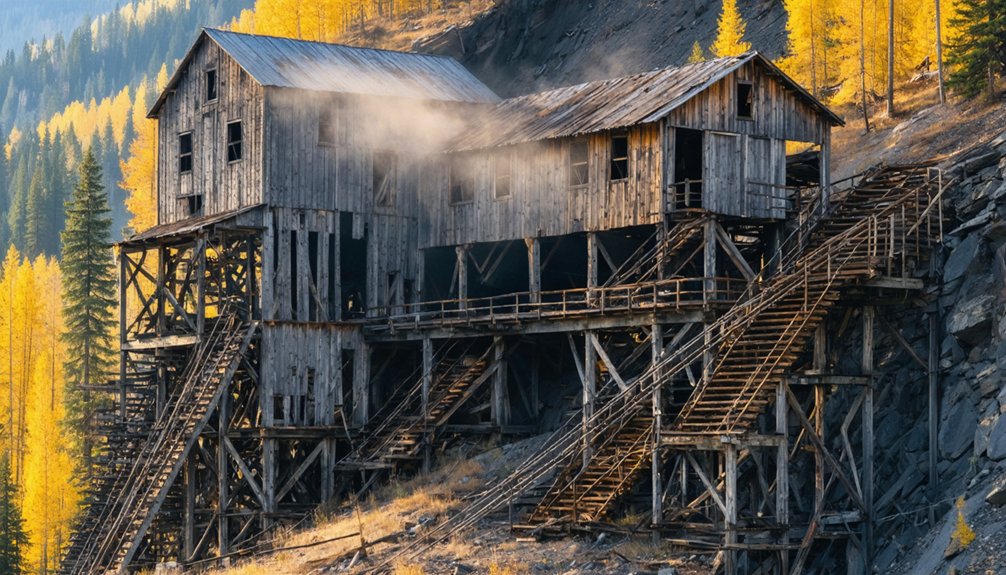You’ll find the Seafoam Mine ghost town perched at 7,598 feet in Custer County, Idaho, where underground mining operations extracted gold, silver, copper, zinc, and lead from 1925 to 1960. The site peaked in 1948, shipping 467 tons of ore, before market instability led to its closure. Today, you can explore well-preserved mining structures and an intact mill building, though you’ll need a 4WD vehicle to access this remote piece of Idaho’s mining heritage.
Key Takeaways
- Seafoam Mine Ghost Town sits at 7,598 feet in Custer County, Idaho, featuring preserved mining structures and an intact mill building.
- The mine operated from 1925 to 1960, producing gold, silver, copper, zinc, and lead, with peak production of 467 tons in 1948.
- Access requires 4WD vehicles via Railroad Ridge Mining Road, with best visiting conditions during summer and early fall months.
- Underground workings extend 701 meters into the mountainside, though visitors should exercise caution around unstable structures and tunnels.
- The site offers historic exploration opportunities near Seafoam Lakes, with surrounding granite ridges reaching 10,500 feet in elevation.
The Rise of Seafoam Mining District
The Seafoam Mining District emerged as a significant mineral producer in Idaho during the early 20th century, with operations dating back to at least 1925.
You’ll find that early mining techniques focused on underground extraction, targeting rich geological formations containing gold-bearing pyrite in quartz veins. Located at an elevation of 7,598 feet, the mine operated in challenging mountain conditions.
The district’s initial production was modest, generating less than $400,000 in its early phases, with notable activity spikes in 1902 and 1926. The district’s rich mining history is documented through a detailed Idaho Bureau investigation conducted in 1952, providing valuable geological insights.
Geography and Natural Setting
You’ll find the Seafoam Mine Ghost Town nestled high in Idaho’s Custer County at 7,598 feet, where the rugged northern Rocky Mountains meet the Challis National Forest.
The site’s remote wilderness setting includes dense conifer forests, steep mountain slopes, and proximity to the Salmon River’s drainage system. Located at coordinates 44.5833, -115.06670, the mine site remains a testament to Idaho’s rich mining heritage. The underground workings extend 701 meters into the mountainside, showcasing the extensive mining operations that once thrived here.
The mountainous terrain, characterized by complex geological formations containing valuable mineral deposits, played an essential role in the area’s mining history while creating natural barriers that preserved its isolation.
Remote Mountain Wilderness Location
Nestled deep within Custer County‘s rugged wilderness, Seafoam Mine Ghost Town stands at an impressive elevation of 7,598 feet in Idaho’s remote Seafoam Mining District.
You’ll find this hidden treasure at coordinates 44.5294°N, 115.1281°W, surrounded by the pristine Challis National Forest and the mighty Salmon River watershed.
Remote access to this mountain sanctuary requires traversing challenging terrain and weathering extreme conditions that helped preserve its historic character.
The site’s wilderness exploration opportunities are enhanced by its isolation and untamed surroundings. The area’s geological makeup includes deposits of alluvial sand and various metamorphic formations.
- You’re far from major highways, accessible mainly through dirt roads past old settlements like Wagon Town.
- You’re in public forest land that protects the area’s natural integrity while allowing limited exploration.
- You’re experiencing a true wilderness setting where weather can change rapidly, demanding self-reliance.
Rugged Forest Terrain Surroundings
Within the Northern Rocky Mountains physiographic province, Seafoam Mine‘s rugged forest terrain encompasses a complex geological tapestry of diorite and granitic rocks from the Idaho batholith.
You’ll find this high-altitude wilderness perched at 7,598 feet, where the rugged beauty of Paleozoic sedimentary formations meets Tertiary volcanic strata.
The surrounding forest ecology thrives despite the area’s challenging climate, with cold winters and mild summers typical of mountain environments.
As you explore the terrain, you’ll encounter a landscape shaped by complex folding and faulting, creating dramatic variations in elevation.
The mine’s remote setting among dense forests and river tributaries offers a glimpse into nature’s raw power, where geological forces have created both mineral wealth and stunning mountain vistas.
Mining Operations Through Time
The Seafoam Mine‘s underground operations began around 1925, utilizing early 20th-century extraction methods and basic mining equipment typical of that era.
You’ll find that the mine’s initial focus was on placer gold mining near the original settlement before operations shifted to underground lode mining for gold as the primary commodity.
While specific production figures aren’t publicly recorded, you can trace the mine’s active years through the 1950s, when geological investigations revealed additional deposits of silver, copper, zinc, and lead alongside the primary gold extraction.
Early Equipment and Methods
Mining operations at Seafoam began with rudimentary tools and manual labor, as prospectors tackled the challenging 7,598-foot elevation using hand steel, hammers, and black powder for initial tunneling. Fire safety was critical, with miners implementing dry chemical suppressants to protect equipment and workers.
You’ll find that early miners relied heavily on hand tools like single-jack and double-jack drills to create blast holes in the hard rock. As blasting techniques evolved, miners switched from black powder to more effective dynamite.
Essential mining methods included:
- Manual ore extraction using picks, shovels, and ore carts on narrow-gauge tracks
- Extensive timbering to prevent tunnel collapse in the underground workings
- Hand sorting of ore at the surface before crushing and processing
The challenging terrain meant most equipment had to be dismantled, transported by pack animals, and reassembled at the mine site.
Peak Production Years
As primitive tools gave way to more advanced equipment, Seafoam Mine launched its peak production period in 1925.
You’ll find that while this marked the height of mining activity, the operation remained relatively small compared to Idaho’s more prominent districts.
During 1925-1927, underground workings extracted gold as the primary commodity, along with copper, silver, zinc, and lead as secondary minerals.
The mine’s economic significance was modest, with the entire Seafoam district’s production valued at less than $400,000.
The Greyhound Mine vein produced silver-rich ore averaging 20 ounces per ton during this period.
You won’t find any records of sustained large-scale operations beyond the late 1920s.
Instead, peak mining activity gave way to sporadic production throughout the 20th century, influenced by the region’s challenging terrain, transportation difficulties, and fluctuating market conditions.
Life in the Mining Camp
Living conditions at Seafoam Mine’s camp exemplified the harsh realities faced by Idaho’s early mining communities.
You’d find tight-knit groups of miners sharing basic amenities while working long hours at 7,598 feet elevation. Camp life revolved around the daily grind of underground mining, with miner camaraderie helping workers cope with the physical demands and isolation. The miners extracted valuable minerals including gold, lead, and silver from the region’s rich deposits.
- Mining families often lived in nearby towns rather than at the remote work site, creating a distinct separation between work and home life.
- Social activities centered around outdoor recreation and community gatherings, offering brief respites from the demanding work schedule.
- The camp’s social structure reflected typical mining hierarchies, with managers and owners holding greater influence over daily operations.
Historical Production and Economic Impact

Though its overall production records remain incomplete, the Seafoam Mine operated as a small-scale polymetallic operation from 1925 to 1960, reaching its peak output in 1948 with 467 tons of ore shipped.
Despite limited records, the Seafoam Mine’s small-scale operations peaked in 1948, producing 467 tons of polymetallic ore.
You’ll find that economic fluctuations in metal prices, particularly gold, copper, silver, zinc, and lead, heavily influenced the mine’s success. During the 1950s, the operation contributed to the district’s impressive $47.5 million combined output, with cobalt selling at $2.30 per pound under government contracts.
Mining technology at the site centered on underground extraction methods, with workings established at 7,598 feet elevation.
While rehabilitation efforts worth $35,000 were attempted in the early 1980s, market instability ultimately prevented the mine’s revival.
Notable Characters and Stories
While the Seafoam Mine‘s operational history spans decades, its human stories center around key figures like William Swigert, who owned and operated the mine during its productive years. Early miners arrived in the region seeking their fortune, much like British-born settler Alexander Barclay in 1836.
The mine’s community stories reflect the resilient spirit of early settlers who braved challenging conditions to establish mining camps and small towns in Custer County’s rugged terrain. Idaho’s arid climate conditions helped preserve many of the original structures at the site.
Mining legends from the Seafoam Mine paint a vivid picture of frontier life:
- Early miners focused on extracting valuable lead and silver deposits, contributing to Idaho’s burgeoning mineral industry.
- Buffalo roamed the valley before settlers arrived, highlighting the untamed nature of the region.
- The mine’s eventual abandonment led to ghost town tales that continue to captivate visitors, preserving the area’s rich mining heritage.
Preservation and Environmental Legacy

Despite efforts to preserve the historical value of Seafoam Mine, its environmental impact remains a complex legacy of Idaho’s mining era.
The Seafoam Mine stands as a stark reminder that our industrial heritage often comes with lasting environmental consequences.
You’ll find evidence of open pit mining that exposed hazardous elements like selenium and heavy metals, which continue to threaten local watersheds and ecosystems. The site’s proximity to critical water systems has drawn attention from environmental groups seeking stronger legal protections.
While various agencies oversee environmental remediation efforts, the challenges persist.
Acid mine drainage, contaminated soils, and disrupted habitats pose ongoing risks to water quality and wildlife. The mining operation’s physical footprint has left lasting marks on the landscape, including waste rock piles and altered vegetation patterns.
Native species like the Sacajawea bitterroot face continued pressure from historic disturbances, highlighting the need for thorough restoration.
Exploring the Site Today
Today, visitors to Seafoam Mine encounter a well-preserved slice of Idaho’s mining heritage situated at an elevation of 7,598 feet in Custer County. Since it’s located on private property, you’ll need to secure permission before exploring the historic site.
The ghost town‘s intact mill building and mining structures offer fascinating glimpses into early 20th-century operations.
When planning your visit, remember these essential safety precautions:
- Wear sturdy hiking boots and bring navigation tools
- Pack plenty of water, snacks, and weather-appropriate clothing
- Stay clear of unstable underground workings and follow posted signs
You’ll find numerous photographic opportunities among the standing structures, but exercise caution around dilapidated buildings.
The site’s remote location demands thorough preparation, while its rich mining history rewards careful exploration.
Nearby Attractions and Access Routes

As visitors venture beyond Seafoam Mine, they’ll discover a wealth of natural and historical attractions throughout Idaho’s rugged mountain landscape.
You can explore the serene Seafoam Lakes cluster, including Josephus Lake, where fishing and hiking opportunities abound. The surrounding granite ridges rise to 10,500 feet, offering spectacular wildflower displays and panoramic vistas.
For those interested in historical significance, you’ll find the Silver Valley Historic Mining Area and the preserved Oasis Bordello Museum in Wallace, both offering glimpses into Idaho’s mining heritage.
Access to these recreational activities typically requires 4WD vehicles or ATVs via Railroad Ridge Mining Road or Road 010. Plan your visit during summer or early fall, as winter conditions often make roads impassable.
Stanley serves as your ideal base camp, providing necessary services and lodging.
Frequently Asked Questions
Were Any Major Accidents or Disasters Reported at the Seafoam Mine?
Unlike the infamous Sunshine Mine disaster’s dark shadow, you won’t find any major historical incidents or mine safety catastrophes reported at this site – records show no significant accidents worth documenting.
What Indigenous Tribes Originally Inhabited the Area Around Seafoam Mine?
You’ll find the Shoshone, Bannock, and Nez Perce Native American tribes historically inhabited this region, moving seasonally through the area for hunting and gathering, maintaining deep cultural significance to the land.
Did the Mine Operate During World War II?
While mine production records don’t clearly confirm operation during World War II, you’ll find Seafoam’s nearby neighbor, the Stibnite mine, was far more active producing strategic wartime minerals.
Are There Any Surviving Maps of the Underground Mine Tunnels?
While over 3,800 feet of drill holes documented ore deposits, you won’t find detailed tunnel maps today. Historical preservation efforts reveal only basic geologic sketches showing surface workings for underground exploration.
What Happened to the Mining Equipment When the Mine Closed?
You’ll find most mining equipment was either salvaged for other operations or left as abandoned machinery. Some pieces remain on-site as remnants of the past, though they’re not part of formal historical preservation.
References
- https://westernmininghistory.com/mine-detail/60001728/
- https://yellowpinetimes.wordpress.com/2025/10/05/idaho-history-oct-5-2025/
- https://www.magellancoppergold.com/blank-2-1-1-1
- https://www.mindat.org/loc-140406.html
- https://history.idaho.gov/wp-content/uploads/2018/08/0009.pdf
- https://westernmininghistory.com/mine-detail/10070827/
- https://thediggings.com/mines/usgs10070827
- https://www.idahogeology.org/Uploads/Data/USBM-Publications/MLA_87-83.pdf
- https://www.mindat.org/loc-39488.html
- https://www.idahogeology.org/pub/Pamphlets/P-96.pdf



